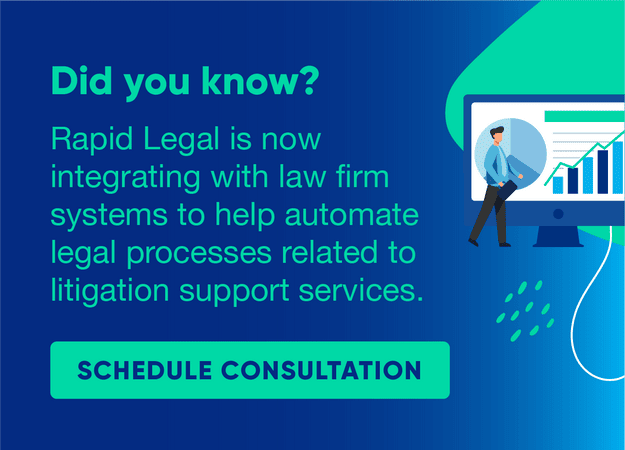
Process servers are the hands and legs of civil litigation. Millions of dollars in fees and settlements hinge on good process serving, so it is critical to have a reliable process service provider who can serve documents promptly and keep cases from becoming problematic as they move upstream. This article helps law firms recognize the traits of a process server that is reliable, effective, and can serve as a strategic partner to the firm.

Where do good process servers come from?
Since most states require no special licensing or education for process serving, it is not uncommon to hear the refrain, “Almost anyone can be a process server.” Nothing could be further from the truth.
Good process servers are prized for their efficiency, efficacy, and reliability. But there is a more specific set of qualities that separate excellent process servers from the merely adequate. They include:
- Resourcefulness
- Patience
- Industriousness
- Craftiness
These four qualities are especially important when a process server is attempting to serve parties likely to evade service. Defendants may attempt to dodge service through behaviors that range from not answering a door knock to moving out of state. A professional process server knows how to deal with these behaviors, overcome them, and successfully serve legal papers.
Qualities to focus on when evaluating a potential process server:

Resourcefulness
A process server who is resourceful can adjust to variables such as location, presentation, and identity, to get documents served. Here is an example of how a resourceful process server might make those adjustments to serve an evasive party:
Floral delivery: In this scenario, the process server assumes the role of delivery person and stages a delivery to the defendant at a bona fide event such as a defendant’s birthday, anniversary, or holiday observation.
If the person who answers the door hesitates to allow the process server inside the home, the process server overcomes those objections by stating that the floral arrangement must be handed over personally to the party being served.
Upon encountering the party face-to-face, the server asks, “Are you Jane Doe?” The party responds in the affirmative and the process server hands over the documents to the defendant, along with the flowers.
Other approaches some resourceful process servers have used include dressing as a pizza delivery person and attaching a subpoena to the inside of a pizza box, or to wearing clothing like a commercial parcel delivery service and either handing over documents or attaching them to a box.

Patience
It is sometimes more cost-effective to wait out a party rather than return multiple times to a bad address. A good process server knows that in some cases the most efficient solution is to wait for a party to appear at a location where the individual is known to frequent. This requires only that the server exercise patience and make the serve lawfully. (They may even offer a stakeout, which is typically an additional fee.)
Some process servers may be tempted to bend the rules and leave documents at a location even when the party to be served is nowhere in sight. To avoid this type of service, which will jeopardize a lawsuit, law firms should research the provider’s reputation to assure their serves are ethical and stand up to scrutiny.
Industriousness
Process serving is not a 9 to 5 occupation. A high-performing process server will be diligent and willing to put in long hours or work odd schedules as a matter of course. This is especially helpful when defendants are unlikely to be at a particular location at a specific time.
In this case, the process server overcomes an evasive defendant simply by putting in the time, travel, and effort to meet the party when and where that person becomes available.
Craftiness
A process server who is crafty may combine resourcefulness, industriousness, and patience to successfully serve court documents. Leveraging these qualities to identify a good address for service is one of the most productive things a process server can do.
To establish a good address the process server may ask neighbors or other locals about information that can help determine where a party lives, when the party may be at a residence, and where the party may go when he or she leaves the residence. Following is an example of how a crafty process server may execute this:
Package delivery: In this scenario, the process server carries a package marked for delivery to the defendant. Instead of going to the defendant’s address the process server approaches a neighbor’s door and says, “Hello, I have a delivery for John Doe.”
The neighbor may respond with, “John Doe doesn’t live here, he lives in the house across the street. You have the wrong address.”
Another response may be, “John Doe used to live here but he moved across the street 5 years ago.”
As the process server leaves, he may ask, “Do you know whether John Doe is home right now so I can deliver this?” The neighbor may respond: “Yes, he is,” or, “No, John usually doesn’t arrive home until about 7 p.m.”
Now the process server has actionable information that can be used to pinpoint a good address or guide further investigation to ascertain the correct address.
The time and effort spent validating that address oftentimes will be less costly than making multiple attempts at a bad address. That is important because it typically costs money each time service is attempted.
Research and technology
A crafty process server will also be a skilled researcher and an expert in making serves as efficient as possible. Again, this is vital for dealing with hard-to-serve parties, and one way a crafty server will tackle such assignments is to use technology that performs skip tracing. Parties associated with debt-collection cases oftentimes may avoid service by moving out of town or out of state. Skip tracing can help locate these individuals so that papers can be served.
Another tactic a good process server may use is to simply leave papers with a party being served. This can be an effective tactic should the party refuse to take the documents in hand.

Success indicators
A process server worth having is one that is experienced and has statistics to back up any claims about performance. One good way to judge a service of process provider is to ask about that provider’s serve success rate.
A high serve success rate indicates that a process server is consistently successful in serving case participants. Anything above 90% is good.
Additionally, a good process server will have a reputation for serving parties quickly and promptly delivering proof of service. A desirable process server will also be a capable researcher who uses online resources to maximize the effectiveness of in-person work.
Speed of Service
Gaging a process server’s speed of service means looking at how quickly the provider can successfully complete a serve as well as how quickly the Proof of Service is delivered back to the law firm. For example, a process server may require 10 days to get someone served, and an additional 3 days to complete and provide the Proof of Service to the firm. It is important to understand the average amount of time required for both of those processes in order to accurately estimate speed of service.
Customer Service
Law firms should also be sure to ask a process serving company how serious it is about customer satisfaction. It’s important to ask the provider how it tracks customer satisfaction and whether it can show proof of satisfaction scores or reports. And it is vitally important to ask what the provider does when customers are not satisfied.
Do you think you know a good service of process provider when you see one? Test your knowledge here:
What to Look for When Hiring a Process Serving Company.
California Process Server RequirementsIn California, a person who wants to become a registered process server will have to go through several steps to achieve registration. According to the California Association of Legal Support Professionals (CALSPro), becoming a registered process server in the state requires the following:
In California process servers are not required to be licensed, according to the National Association of Professional Process Servers (NAPPS). The association points out, however, that any individual who serves more than 10 papers annually must be registered either in the county in which they live or have their primary place of business. |

The Process Server’s Bread and Butter:
Service of Process
Process servers handle a variety of court documents ranging from subpoenas and complaints to eviction notices and summonses. Those documents all have important functions that operationalize once handed over by a process server, but the one document a process server carries that confers possibly the most gravitas of all is service of process.
Following is a brief examination of what service of process is, how it is carried out, and what distinguishes it from other terms that sound similar but are quite different.
Service of process methods
For the most part, service of process must be done in person. But is that the only way?
Not always.
Personal service and substituted service are two common types of service of process used in the United States, with personal service being the one most difficult for a defendant to attack for its legality.
Another method used to perform service of process is publication. For example, publication in a newspaper.
Publication as a process serving method may be useful if a defendant cannot be located. This method provides constructive notice as opposed to actual notice. It is also considered the lowest constitutionally acceptable form of service. In the state of California service via publication is authorized by Code of Civil Procedure 415.50.
Service of process may also be conducted via public posting. This method is sometimes used when a defendant cannot be located. As the name suggests, public posting is performed by posting a notice in a place the defendant is known to frequent.
While Public posting is used to perform service of process it sometimes may be problematic. For example, using the public posting method may imply that the plaintiff knows where the defendant frequents but was possibly lax in efforts to find the defendant. Public posting may also suggest the plaintiff only guessed at places the defendant may frequent.
Details governing the use of public posting in California
appear in Code of Civil Procedure 415.45.
In some cases, service of process may even be performed using social media such as Facebook. This service of process method is rare, however, and still in its infancy.
Service of Process vs. Giving Notice
There is a difference between documents that can—or must—be served personally (service of process) and documents that can be eServed, mailed, or handled by other means (eService). The difference between these two types of documents lies in the results they create, and here are the critical distinctions you should know.
eService: Giving notice
The role of eService in civil litigation is straightforward: eService is an electronic substitute for service on opposing counsel. This aspect of civil litigation traditionally has been executed with paper documents such as printed facsimiles or the U.S. Mail.
In the 21st century, however, things are different. Now, online technology and email make it possible for document exchange to occur electronically. But not without a catch.
For example, in the state of California, papers can be served electronically only if a party or other person has expressly consented to receive electronic service in that specific action.
Another notable restriction on eService in California is that some documents simply are not allowed to be exchanged electronically. For example, a document required to be served by certified or registered mail is not authorized for electronic service.
Service of process: Getting jurisdiction
Service of process is performed when a party other than the plaintiff gives a copy of the court papers to the party the plaintiff is suing. Service advises the other party of three critical things:
-
- What the plaintiff is asking for
- Date and place of the trial
- What the party can choose to do
Looking deeper at service of process we see that it gives the court the power to adjudicate a case or issue. We also see that it gives the court the “power” to command witnesses to appear: it confers jurisdiction.

Proof of service procedures
Personal service vs. substituted service
Once you’ve decided on a provider for you service of process, you’ll need to determine which method of service will be used.
There are three primary methods for service of process: 1.) actual or personal service; 2.) substituted service, 3.) service by publication. The two methods that are most common are personal service and substituted service.
Personal service may be as simple as approaching the person to be served and saying, “These are court papers.” Then, present the person copies of all papers checked on the form, or leave the documents within close proximity. An easy speaking distance is a good rule of thumb for judging this distance. It isn’t always that simple, but rarely is it a dangerous game of cat-and-mouse carried out in dark alleys.
Substituted service is a method that can be used when the plaintiff doesn’t want to use personal service or may not be able to locate the party to be served. To perform substituted service the person performing service must be at least 18 years of age and not listed in the case. Substituted service also requires the additional step of mailing another copy of the papers by first class mail to the party being sued at the same address where the papers were left.
For substituted service, state law may require that documents be mailed to the party being served in addition to standard substituted service requirements. This is currently the case in California, New York, and Illinois, so it is important to find out whether your state requires this additional task.

Process server: a law firm’s strategic partner
At the highest level of process servers are those who have the right stuff to become a strategic partner. A vendor that is qualified to fill this role may be affiliated with a larger litigation support service provider and, thus, invisible to the law firm itself. The litigation support service provider brings value to the law firm, however, with deep industry experience, a technology platform that delivers efficiency, and a provable history of high performance.
Technology for process serving
As a strategic partner, the litigation support service provider uses its technology platform to innovate a better way for the law firm to operate. One way it can do that is to make data about process service orders in the provider’s own system shareable with the law firm’s systems. This can be especially useful by making data instantly available about billing, court fees, vendor fees, and payments for process serving orders.
Interested in Learning Other Process Serving Technology Use Cases?
Read: Technology Your Process Server Should Be Using
Data is better than a crystal ball
If you’re unclear about how sharing this data positively impacts the bottom line, think of it this way: For each case, every transaction receipt and every document can be stored in a law firm’s own system. This means fees and payments can be easily accounted for and reimbursed when the case ends, dramatically collapsing the time needed to reconcile expenses.
A portal also allows the vendor to manage and efficiently track the performance of its affiliate network in executing the serve. This, in turn, builds an extremely high level of accountability felt all along the service of process supply chain.
The portal also creates two other important advantages to improve service of process efficiency: it eliminates paper controls and allows the server to eSign the proof of service.

Measure the results
Sharable data can also be used to create strategic reports. These reports provide detailed views of service of process orders and the vendor’s execution thereof, as well as other order types placed through the portal. At a glance, users can see which types of orders contribute positively to the firm’s bottom line and which types compromise it.
Most law firms lack the infrastructure and staff to collect business intelligence at this level easily. That’s why it’s important to have a vendor whose technology makes it simple to gather and share it. If your litigation support service provider isn’t able or willing to deliver this sort of value to help you grow, it’s probably time to find one that will.
4 ways you should be using sharable data in your firm’s business strategy:
- Service level distribution
- Orders by type
- Service of process orders by pricing zone
- Service of process performance
Read Technology Your Process Server Should Be Using and learn how these reports can save money for your law firm!

Expert advice is a click away
By reading this article, you’ve taken an important first step toward building your process serving expertise. The thing to remember about process serving—as the term implies—is that it is a process. It is a task filled with nuance that won’t be mastered overnight. So don’t be afraid to seek advice and expertise.
Rapid Legal possesses some of the industry’s deepest process serving expertise, thanks to staff members who have decades of hands-on, practical experience as professional process servers. That expertise is built into our technology platform to make it easy for you to fulfill your process serving needs from a single, simple-to-use source.
If you’d like to see for yourself how process serving can be done conveniently from our online portal, contact one of our account executives for a no-obligation demonstration.
Book a demo or schedule a call
with a Rapid Legal team member now.
Be part of your firm’s success story by choosing a litigation support service partner who has your back when it’s time to make critical decisions about this function. Ask us anything and don’t worry about being judged.
There is no judgement. At least not until the court papers are served.

Addendum:
Most commonly served documents
A process server’s toolkit primarily consists of documents: paper or electronic. Each document performs a distinct function and some will significantly alter the course of business or relationships.
It’s critical to understand the legal action each document triggers, so we’ve defined them here in alphabetical order:
Complaint: The initial pleading in which an action is commenced and sets forth a claim for relief. The filing of the complaint is a charge against a defendant or several defendants and sets forth a cause or causes of actions against them.
Notice of Motion: A notice in writing stating that a certain day designated a motion will be made to the court for the purpose or object stated. The notice is served on opposing counsel and all parties and gives all parties a time and date for the court hearing.
Notice to Quit: This notice is given to tenants to terminate the tenancy of the premises. The notice states that at the end of the specified date, the tenancy is terminated and directs that the tenant must move out.
Notice to Pay Rent or Quit: A notice to a tenant of a rental property, informing him or her that the rent or a portion of the rent is due. Service on the tenant in writing that the rent is due usually in three days after the date of service, and if the rent is not paid, the tenant is requested to “quit” (leave) the premises.
Opposition: A pleading filed to oppose or state a reason a Motion should not be granted, otherwise known as a 1011.
Order for Appearance (ORAP): This is a court order that compels a personal appearance of the judgment debtor. Disobedience of this order by not appearing could subject the judgment debtor to a citation of contempt and ultimately lead to an arrest.
Order to Show Cause: An order to appear as directed, and presents to the court such reasons or considerations as one has to offer why a particular order should not be confirmed, take effect or to be executed.
Plaintiff’s Claim and Order to go to Small Claims Court: A claim of plaintiff is a small claims document filed by the plaintiff against the defendant of defendants. The claim must be for a monetary amount only. The claim is a 5 page document stating how the defendant or defendants damaged the plaintiff and in what amount.
Temporary Restraining Order: This is an order compelling compliance and failure to obey it could result in bringing the person restrained into contempt of court and possible arrest. A TRO is a case matter that might restrain the respondent from calling, harassing or bothering the petitioner. The order is to restrain the person served from doing any act specified in the order until the hearing takes place.
Summons: A writ of process [issued by the clerk of the court] the person named that an action has been commenced against him in the court from where the process issues and that he/she is required to appear.
Subpoena: A command to appear at a certain time and place to give testimony as a witness.
Get Started Today
Spend more time on billable client hours and less time tracking down conformed copies and proofs of service.

